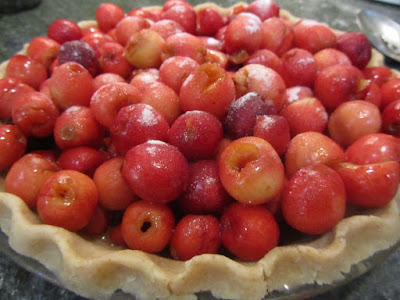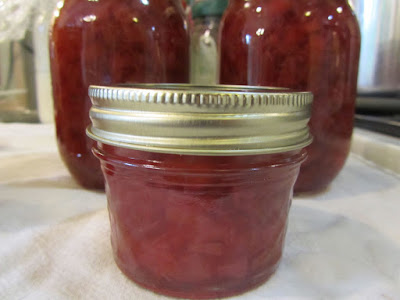 |
I've been baking our sourdough in loaf pans
this spring. For one thing, the slices are
easier to retrieve from the toaster.
For another, it's just a familiar look
to my homemade bread for my family. |
I mentioned last week that my work to improve my sourdough bread had paid off. I read several articles, watched a couple of informative videos, and used some trial and error at home. If I had to pinpoint what really helped with my own sourdough success, I'd have to list these three areas of change:
- time
- temperature
- physical work
Time
Sourdough simply need more time than yeasted bread. The total time for the dough to rise, both as a mass and once in the pans, is far longer than yeasted doughs. Sourdough takes a couple to a few hours to fully rise. Once the dough is in the pans, the rising phase can take up to three hours. Furthermore, while yeasted bread will continue to rise once it's in the oven, sourdough has much less oven-spring. However big your loaf is when you put it in the oven is pretty much the size that you will have once it is fully baked.
Temperature
While you can be somewhat imprecise when working with sourdough, it's ideal temperature range is somewhat important to the natural yeast's activity. Too cool and the natural yeasts don't do much or work very, very slowly (think 5 hours to get a loaf of bread to rise). Too warm and the natural yeasts are toast. In my own kitchen, I've found that my sourdough prefers temps that are right in the range of 70 to 80 degrees F.
My starter will continue to work and bubble at 64 degrees F. But whoa, look out if it's in the 70s for a day. That starter will bubble over the container and spill all over the counter. Sourdough bread dough made on such a warm day will rise, beautifully, in about 1 1/2 to 2 hours.
To give you an idea of how high temperature can bring sourdough activity to a halt, here's what happened to a friend. Several years ago, a friend of mine was beginning to use sourdough starters. He misunderstood just how warm is too warm for a starter and the dough. His sourdough bread had a good taste, but it was quite flat and chewy. Fortunately, he had another friend who walked him through the process and determined that he was adding water which was far too warm for the sourdough yeasts. Once this was understood, this friend was then able to produce really great sourdough bread.
In my own experience this year, I began my starter in the early spring, a time when it's typically still quite cool. Our house is always a bit on the cool side, so I chose to keep my starter in a closed oven with a light on 24/7. When I would place my hand in the lit oven, it would feel quite warm. Pans of bread dough (placed in the lit oven to rise) almost felt hot, they were so warm. My starter did get bubbly, but not overly so. And the bread was good, but not fully risen in those early batches. One morning, I went to check on the starter and noticed the oven light had burned out. I took the starter out of the oven and just started keeping it on the counter. Later that same day, I noticed that the starter was bubbling more vigorously. And my bread was rising more. What I gather from this is that my oven with a light on was at the too warm end of the spectrum for good activity.
In addition to maintaining a better temperature for the starter and rising dough, I've also adjusted the temperature for baking the loaves. I had been baking my sourdough at about 375 degrees F. My reading indicated that I really should be baking sourdough is a hot oven, as much as 475 degrees F. For my own dough, I've found 460 degrees F to be the sweet spot for this kind of bread. I like the color that the bread's crust develops and the interior is nicely baked, yet soft.
Add in a Good Dose of Physical Work
Sourdough bread is not one of those no-work breads. It requires a lot of kneading to activate the gluten. Gluten gives doughs that stretchy texture that will hold the bubbles of gas created by natural or commercial yeasts. Without gluten, those bubbles collapse on themselves, leaving the baker with a flattened loaf. With commercial yeasts, gas bubbles are more durable and reliable, for lack of better words. Even if the gluten has not been fully developed through kneading, its still possible to make a good loaf of no-knead bread by using commercial yeast and giving the dough extra time. In the case of no-knead bread, the mixing of the dough begins the development of gluten, while the additional rise-time allows the commercial yeasts to reproduce. With sourdough, vigorous kneading substantially develops the gluten in the dough, enough so that it can stretch and hold around the bubbles of gas produced by the natural yeasts.
I notice a texture change during the process of kneading the dough. At first, the sourdough feels grainy or gritty. After about 10 to 12 minutes, the dough becomes satiny and smooth. I knead for about 15 minutes and then check the stretch of my dough. There's a bakers' term that describes a technique to see if a dough's gluten development is full -- the windowpane test. If you take a small chunk of dough, flatten it in your fingers, then stretch slowly, a fully-developed dough will stretch until thin. Some say that the dough should be almost transparent (like a window) in the center of this stretched dough. In my own experience, my sourdough doesn't become this stretchy, but it does become thin enough to develop a small hole. In contrast, dough that fails the windowpane test will break off as one tries to stretch it, much like how the kids' product Silly Putty will only stretch so far and then "break" into two pieces.
So, this is what I've been doing with my sourdough for the past month:
- I give the dough ample time to rise, as much as 3 or 4 hours per rising if my kitchen is really cool, but most of the time about 2 hours per rising.
- I bake on days when the kitchen will be around 68 to 78 degrees F in the afternoon hours when my loaves will be rising. This means that I am actually baking the sourdough loaves in the evening, after dinner.
- I now knead my dough for 15 solid minutes. My technique is pretty vigorous. If I didn't have the same strength or endurance for this kind of kneading, I would knead in 5 minute intervals, with however long breaks in between that I needed, to a total of 15 minutes. I check the dough by way of a windowpane test. And then, just for good measure, I knead for another 3 minutes before forming the dough into loaves and placing into pans.
The end result of this "extra" work is really great sourdough bread. Sourdough bread has better keeping qualities than yeasted bread, with the center of each slice being stretchy and soft, days after baking. My family all thinks my bread tastes amazing and is much like what we've sampled in San Francisco at the wharf. For the time being, while I can't buy the large bags of yeast for the $5 to $6 that I am accustomed to, I'll continue with baking sourdough.
If you're interested to know -- I use about 1/3 whole wheat flour and 2/3 white flour for my sourdough. This seems to be a good balance of fiber and nutrients with the softness of an all-white flour bread. For more on the recipe that I use, see the post in this link.
 |
what my previous loaves of sourdough looked like,
in case you were wondering |
On the commercial yeast front, I've been stalking several sites as well as my local restaurant supply for a few weeks, hoping to find the large bags bag in stock on one of the sites that waives shipping fees with minimum purchase or has local availability for me to pick up. I thought this was interesting: on one website's page for large bags of yeast, "Temporarily Unavailable due to Global Shortage." Wow, that really caught my attention, a global shortage. It's no wonder that so many people are trying their hands at sourdough baking right now!



































